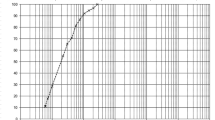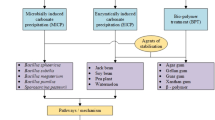Abstract
Laterites are usually considered a good subgrade and sub-base materials in roads and pavements construction within tropical and subtropical regions because of their availability and affordability. In most cases, they are assumed to have homogeneous properties because of their similarity in appearance. However, the variations in the geochemical composition of their parent rocks may have a significant contribution to the geotechnical properties of laterites. To verify this assumption, it becomes imperative to assess the contributions of the geochemical composition of lateritic soils to their geotechnical properties. Consequently, soil samples collected from freshly exposed lateritic deposits were subjected to X-ray diffraction and X-ray fluorescence analysis to determine their geochemical compositions. These samples were further subjected to geotechnical tests following standard procedures to determine their particle size distribution, consistency limits, compaction, and shear strength properties. The results were analysed using statistical correlation analysis to find the relationships between the geotechnical properties of the soils and their geochemical compositions. It was observed that the oxides of silica, aluminium and iron content of the lateritic soils contributed significantly to their index properties such as soil gradation, liquid limit, and plasticity. However, their compaction and strength properties depend on the ratio of the oxides in the soil matrix. Therefore, there is a need for geochemical investigations prior to sourcing laterites as a construction material for the construction of roads and pavements.











Similar content being viewed by others
References
Alabo EH, Pandy P (1987) Distribution of engineering properties of red soils in the central Lower Niger Delta, Nigeria. 9th African Reg. Conf. Soil Mechanics and Found. Engrg, Lagos, p 49–55.
Northmore KJ, Entwisle DC, Hobbs PRN, Jone LD, Culshaw MG (1992) Engineering geology of tropical red clay soils: geotechnical characterization; Index properties and testing procedures. British geological survey, Technical report WN/93/12
Ugbe FC (2011) Basic engineering geological properties of lateritic soils from western niger delta. Res J Environ Earth Sci 3(5):571–577
Aginam CH, Nwakaire C, Nwajuaku AI (2015) Engineering properties of lateritic soils from Anambra Central Zone, Nigeria. Inter J Soft Comput Eng 4(6):2231–2307
Wesley L (2009) Behaviour and geotechnical properties of residual soils and allophane clays. Obras y Proyectos 6:5–10
Adeyemi GO, Wahab KA (2008) Variability in the geotechnical properties of a lateritic soil from South Western Nigeria. Bull Eng Geol Environ 67:579–584
Bayewu OO (2012) Petrographic and geotechnical properties of Lateritic Soils developed over different parent rocks in Ago-Iwoye area, Southwestern Nigeria. Int. J Appl Sci Eng Res 1(4):584–594
Bohmann C, Bohmann D (1990) Phyllosilicates in hydrothermally altered dolerite sills. S. Afr. 1. Geol 93:446–453
Bohmann C, Escott BJ, Hughes JC (2004) Soil mineralogy research in South Africa, 1978 to 2002 - a review. South African Journal of Plant and Soil 21(5):316–329
Fitzpatrick RW, Schwertmann U (1982) Al-substituted goethite - an indicator of pedogenic and other weathering environments in South Africa. Geoderma 27:335–347
Schellmann W (2018) An Introduction to Laterite, Products and processes of intensive rock weathering. Retrieved from http://www.laterite.de/. Accessed 13 March 2018
Bühmann C (1994) Parent material and pedogenic processes in South Africa. Clay Mins 29:239–246
Agumanu EA (2011) Enviroment of deposition of Agwu Formation (late Cretaceous), Southern Benue Trough. Nigeria Global J geological sciences 9(2):215–228
Mbagwu JSC, Auerswald K (1999) Relationship of percolation stability of soil aggregates to land use, selected structural indices and stimulated rainfall erosion. Soil Till Res 50:197–206
Emeh C, Igwe O (2018) Effect of environmental pollution on susceptibility of sesquioxide-rich soils to water erosion. Geol, Ecol, Landsc,. https://doi.org/10.1080/24749508.2018.1452484
Oti NN (2002) Discriminant functions for classifying erosion degraded lands at Otamiri Southeastern Nigeria. Agro-Sci 3(1):34–40
Igwe CA, Zarei M, Stahr K (2009) Mineralogy and geochemical properties of some upland soils from different sedimentary formations in Southeastern Nigeria. Aust J Soil Res 47:423–432
Tuncer ER (1976) Engineering behavior and classification of lateritic soils in relation to soil genesis. Retrospective Theses and Dissertations. 5712. https://lib.dr.iastate.edu/rtd/5712
Rahardjo H, Aung KK, Leong EC, Rezaur RB (2004) Characteristics of residual soils in Singapore as formed by weathering. Engg Geol 73:157–169
Ismaiel HAH (2006) Treatment and improvement of the geotechnical properties of different soft fine grained soils using chemical stabilization. PhD. thesis, Institute of Geology, Martin Luther Halle-Wittenberg University, Germany.
Emeh C, Igwe O (2016) the combined effect of wood ash and lime on the engineering properties of expansive soils. Int J Geotech Eng 10(3):246–256
Nwajide SC (1990) Cretaceous Sedimentation and Paleogeography of the Central Benue Though. In: Ofoegbu, C.O (Ed.) The Benue Tough structure and Evolution. International Monograph Series, Braunschweig, pp. 19–38.
Kogbe CA (1989) Palaeogeographic history of Nigeria from Albian times. In: Kogbe CA (ed) Geology of Nigeria. Elizabethan Publ, Co, Lagos, pp 257–275
Ojoh KA (1992) Southern part of the Benue trough (Nigeria): cretaceous stratigraphy, Basin-Analysis, Palaeo-oceanography and geodynamic evolution in the equatorial domain of the south Atlantic. Natl Assoc Petroleum Explor Bull 7:131–152
Obi GC, Okogbue CO, Nwajide CS (2001) Evolution of the Enugu Cuesta: a tectonically driven erosional process. Global J Pure Appl Sci 7:321–330
Reyment, R. (1965). Aspects of the Geology of Nigeria. University of Ibadan Press, p 144
Hoque M, Ezepue MC (1977) Petrology and Palaeo-geography of the Ajali Sandstone. Nig J Min Geol 14(1):16–22
Ibe KK, Akaolisa CCZ (2010) Sandclass classification scheme for Ajali sandstone units in Ohafia area, Southeastern Nigeria. J Geol Min Res 2(1):16–22
Nwajide SC (1979) A lithostrtigraphic analysis of the Nanka sands of southeastern Nigeria. Jour Min Geol 16(2):103–109
Arua I, Rao VR (1987) New stratigraphic data on the Eocene Ameki Formation, south-eastern Nigeria. J Afr Earth Sc 6(4):391–397
Okagbue CO, Ezechi JI (1988) Geotechnical characteristics of soils susceptible to erosion in Eastern Nigeria. Bulletin Int Assoc Eng Geology 38:111–118
Emeh C, Igwe O (2017) Variations in soils derived from an erodible sandstone formation and factors controlling their susceptibility to erosion and landslide. J geol soc India 90(3):362–370
Onwuka OS, Uma KO, Ezeigbo HI (2004) Portability of shallow groundwater in EnuguSoutheast Nigeria. Global J Environ Sci 33(1):33–39
Offodile ME (2002) Groundwater study and development in Nigeria, Mecon geology and engr. Services ltd., Jos 453, p223
Eze HI (2007) Effect of rain fall intensity and energy on gully development in North eastern Enugu stateNigeria Nigerian. j technol 26(1):91–96
ASTM D2487-11 (2011) Standard practice for classification of soils for Engineering purposes (Unified Soil Classification System), ASTM international, West Conshohocken, PA, 04.08
British Standard Institute (1975) Method of testing soils for civil engineering purposes. BS 1377
ASTM D3080–04 (2004) Standard Test Method for Direct Shear Test of Soils under Consolidated Drained Conditions
Davis BL (1987) Quantitative determination of mineral content of geological samples by X-ray diffraction: Discussion. Am Miner 72:418–440
Obonyo EA, Kamseu E, Lemougna PN, Tchamba AB, Melo UC, Leonelli C (2014) A Sustainable approach for the geopolymerization of Natural Iron-Rich Aluminosilicate Materials. Sustainability 6:5535–5553. https://doi.org/10.3390/su6095535
Townsend FC, Reeds LW (1971) Effects of amorphous constituents on some mineralogical and chemical properties of a Panamanian latosol. Clays Clay Miner 19:303–310
Arora KR (2008) Soil mechanics and foundation engineering, 7th edn. Standard publishers distributors, Delhi, p 942
Stoops G, Marcelino V (2018) Lateritic and Bauxitic Materials. In: Stoops G, Marcelino V, Mees F (eds) Interpretation of Micromorphological Features of Soils and Regoliths (Second Edition). Elsevier, pp 691–720
Bell FG (2007) Engineering geology, 2nd edn. Elsevier Ltd., Oxford, UK, p p227
Arias MM, Barral T, Dias-Fierros F (1995) Effects of iron and aluminium oxides on the colloidal and surface properties of kaolin. Clays Clay Miner 43(4):406–416
Railsback LB (1993) A geochemical view of weathering and the origin of sedimentary rocks and natural waters. J Geol Educ 41(5):404–411
Nicholson P, Kashyap V, Fuji C (1994) Lime and fly ash admixture improvement of tropical Hawaiian soils. Transp Res Rec, Washington, DC, No 1440:71–78
Arvelo AM (2004) Effects of the soil properties on the maximum dry unit weight obtained from the standard proctor test. MSc. Thesis, Department of Civil and Environmental Engineering, University of Central Florida Orlando, Florida. http://stars.library.ucf.edu/etd/161
Tutumluer E, Mishra D, Butt AA (2009) Characterization of Illinois aggregates for subgrade replacement and subbase. Research Report ICT-09–060, Illinois Centre for Transportation
Wu W, Berhe TG, Ashour T (2012) Embarkment and dams. In: Hall MR, Lindsay R, Kryenhoff M (eds) Mordern Earth Buildings. Woodhead Publishing Series in Energy, Woodhead publishing, pp 538–558
Moore R (1991) The chemical and mineralogical controls upon the residual strength of pure and natural clays. Géotechnique 41(1):35–47. https://doi.org/10.1680/geot.1991.41.1.35
Dimitrova RS, Yanful EK (2012) Factors affecting the shear strength of mine tailings/clay mixtures with varying clay content and clay mineralogy. Eng Geol 125:11–25. https://doi.org/10.1016/j.enggeo.2011.10.013
Wang JJ, Zhang H, Tang S, Liang Y (2013) Effects of particle size distribution on shear strength of accumulation soil. J Geotech Geoenviron Eng 139(11):1994–1997
Hamidi A, Azini E, Masoud B (2012) Impact of gradation on the shear strength-dilation behavior of well graded sand-gravel mixtures. Scientia Iranica 19(3):393–402
Igwe O, Sassa K, Fukuoka H (2009) The Geotechnical Properties of Sands with Varying Grading in a StressControlled Ring Shear Tests. Electron J Geotech Eng 14:1–21
Cornell RM, Schwertmann U (2003) The Iron Oxides, 2nd edn. Wiley-VCH, Weinheim, p 664
Peng X, Sun H (2015) Assessing the contributions of sesquioxides and soil organic matter to aggregation in an Ultisol under long-term fertilization. Soil and Tillage Research 146:89–98
Amu OO, Ogunniyi SA, Oladeji OO (2011) Geotechnical properties of lateritic soil stabilized with sugarcane straw ash. Am J Sci Ind Res 2(2):323–331
Acknowledgements
Authors are grateful to Mr. Michael and Mr. Kazeem of the Nigerian geological survey agency for providing laboratory assistant. They are also grateful to Mr. Idris and Ms. Chidinma for providing assistant during the field work, and to Ms. Anulika for proofreading and improving the English language quality of this work.
Funding
Authors declare that no funds, grants, or other support was received for this research.
Author information
Authors and Affiliations
Corresponding author
Ethics declarations
Conflict of interest
All authors certify that they have no affiliations with or involvement in any organization or entity with any financial interest or non-financial interest in the subject matter or materials discussed in this manuscript. Also, the authors did not receive support from any organization for the submitted work.
Additional information
Publisher's Note
Springer Nature remains neutral with regard to jurisdictional claims in published maps and institutional affiliations.
Rights and permissions
About this article
Cite this article
Onwo, E.S., Emeh, C. & Igwe, O. Effect of Geochemical Composition of Lateritic Soils on their Geotechnical Properties. Indian Geotech J 52, 877–894 (2022). https://doi.org/10.1007/s40098-022-00628-w
Received:
Accepted:
Published:
Issue Date:
DOI: https://doi.org/10.1007/s40098-022-00628-w




